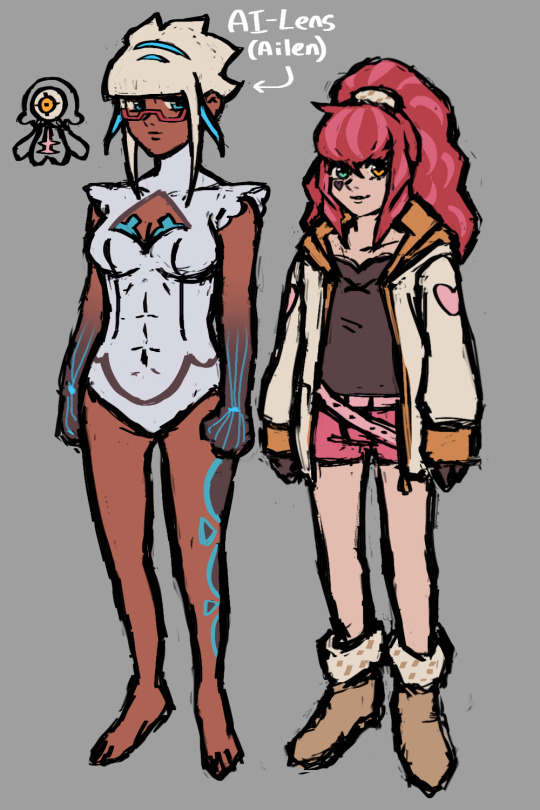#friendly AI
Explore tagged Tumblr posts
Text
The allure of speed in technology development is a siren’s call that has led many innovators astray. “Move fast and break things” is a mantra that has driven the tech industry for years, but when applied to artificial intelligence, it becomes a perilous gamble. The rapid iteration and deployment of AI systems without thorough vetting can lead to catastrophic consequences, akin to releasing a flawed algorithm into the wild without a safety net.
AI systems, by their very nature, are complex and opaque. They operate on layers of neural networks that mimic the human brain’s synaptic connections, yet they lack the innate understanding and ethical reasoning that guide human decision-making. The haste to deploy AI without comprehensive testing is akin to launching a spacecraft without ensuring the integrity of its navigation systems. The potential for error is not just probable; it is inevitable.
The pitfalls of AI are numerous and multifaceted. Bias in training data can lead to discriminatory outcomes, while lack of transparency in decision-making processes can result in unaccountable systems. These issues are compounded by the “black box” nature of many AI models, where even the developers cannot fully explain how inputs are transformed into outputs. This opacity is not merely a technical challenge but an ethical one, as it obscures accountability and undermines trust.
To avoid these pitfalls, a paradigm shift is necessary. The development of AI must prioritize robustness over speed, with a focus on rigorous testing and validation. This involves not only technical assessments but also ethical evaluations, ensuring that AI systems align with societal values and norms. Techniques such as adversarial testing, where AI models are subjected to challenging scenarios to identify weaknesses, are crucial. Additionally, the implementation of explainable AI (XAI) can demystify the decision-making processes, providing clarity and accountability.
Moreover, interdisciplinary collaboration is essential. AI development should not be confined to the realm of computer scientists and engineers. Ethicists, sociologists, and legal experts must be integral to the process, providing diverse perspectives that can foresee and mitigate potential harms. This collaborative approach ensures that AI systems are not only technically sound but also socially responsible.
In conclusion, the reckless pursuit of speed in AI development is a dangerous path that risks unleashing untested and potentially harmful technologies. By prioritizing thorough testing, ethical considerations, and interdisciplinary collaboration, we can harness the power of AI responsibly. The future of AI should not be about moving fast and breaking things, but about moving thoughtfully and building trust.
#furtive#AI#skeptic#skepticism#artificial intelligence#general intelligence#generative artificial intelligence#genai#thinking machines#safe AI#friendly AI#unfriendly AI#superintelligence#singularity#intelligence explosion#bias
8 notes
·
View notes
Text


Remember, it's never too late to pick up a pencil and learn. It may not be easy at first, but trust me it'll be worth it! Like, I know my art isn't "perfect" but I try and that what counts! "It's the journey not the destination"
And for any of you AI bros out there, you don't have to steal, you can embrace what it means to be human and create!
#Plus#NOT making AI images is better for the environment#since generative AI is really bad for the earth#so drawing is more eco friendly too :)#sonic fanart#sonic fandom#amy rose#metal sonic#Never really tried doing sonic fanart before lol#anti ai#human made art#sth fanart#sega sonic
1K notes
·
View notes
Text
Usually finding out you have something in common with a new acquaintance is a positive thing, but sometimes it's extremely dangerous. If I meet someone who's also into writing, that's like an even 50/50 on whether we should be best friends OR whether every time they open their mouth I will be manfully restraining myself from fistfighting them on the sidewalk outside this bougie downtown brunch spot.
#grace for ts#it's because of the unspoken social pressure to Engage People On Things You Have In Common#oh we both like writing? we should talk about writing. we should offer to read each others work. we should form a club#when in actuality maybe i like this person just fine#but their writing is like a radioactive toxin to my soul#and we should just be friendly acquaintances while Never Once Mentioning Writing Again#sometimes its not wanting to tell someone you don't like their stuff cause it's just bad. and they should come back in a couple years#sometimes its people wanting engagement and concrit on their characters and plot#while handwaving the fact that their grammar spellilng and prose craft is just atrocious#like 'oh that can be fixed later!!'#okay but I can't SEE your CHARACTERS AND PLOT through the smoking wreck of the english language you've produced#sometimes it's just a having different style preferences thing (which is sometimes the worst bc it's Good i just Dont Like It)#sometimes its the guy who enthusiastically tells me about his cosmic horror story#and how he sometime asks AI to 'cormac mccarthy it up a little bit'. but only sometimes so it's fine#my eternal quest for a real life writing group continues to crash and burn
478 notes
·
View notes
Text
“don’t blame peoples’ individual choices of using ai for climate change, blame the big corporations!!”
i’m gonna hold your hand when i say this. generative ai is the big corporation, and this product only continues to exist because of peoples’ individual choices to use it
#mal's shitposts#can the same thing be said about other big polluters? absolutely#but we need electricity. we need food. and unfortunately in this current moment we need oil#nobody NEEDS generative ai. nobody#these other big industries can be regulated reorganized to decrease their environmental effects#generative ai could too. but it won’t#because the amount of people using it show the companies that people don’t care about its effects#the ONLY way to make generative ai more environmentally friendly is to completely boycott it
126 notes
·
View notes
Text

psyncer clover au ough
#ailen like ellen the jellyfish#clover is already an agent so this is totally possible imo#tried to keep the gyaru spirit of clover while still looking fight scene friendly#peep ailen looking like alice LOL girlfrens..#zero escape#ai the somnium files#ze aitsf au#my art
101 notes
·
View notes
Text

friendly reminder!! human art—mii art, in this case—is infinitely better!!! 💜🫶✏
————
still ver:


#soundleer's art#soundleer's miis#miis#just made a lil doodle and felt inspired to make a simple gif using only 4 frames (plus 6 duplicates)#hey friendly reminder that i will never support generative ai art! no slop matches our power!!#some ppl should be ashamed of calling themselves a human being like just pick up a pencil please xoxo#anyway im happy with how this piece turned out! i love experimenting things with medibang hyeee#ay it me Leer
155 notes
·
View notes
Text
The easiest and sure way of telling if something is written by ChatGPT is because it always has to, in whatever it writes, to wrap it up with some kind of conclusion (con un moño as I say), and it's VERY, VERY conspicous, there is ALWAYS a conclusion. It's always "in summary/in conclusion/overall/stands as a testament". It NEVER, EVER writes anything without some sort of conclusion, and even if you ask it not to, it always tries to somehow shoehorn some sort of conclusion, summary, or a moral or a happy ending (if you ask it for prose writing), it's deeply coded into it. Another thing, it is always wholesome, eager to please and sickengly optimist, like the most eager costumer service of all time (because it was designed for it and really nothing else), it is almost impossible to ask it to write anything cynical, it's really almost funny how it is.
So, vague, cynical, esoteric, incomprehensible, resentful and rambling pointless rants is the sign of something written by a real human.
#cosas mias#I believe the developers insisted hard into making it have a conclusion all the time to prevent it to rambling on#which ironically makes it hostile bland and less human-friendly to me#please do not add resentful and rambling pointless anti-AI rants here I know they are a sign of humanity but they're really tiresome#feel free to be cynical and rambling about anything else though
174 notes
·
View notes
Text
AI is not a panacea. This assertion may seem counterintuitive in an era where artificial intelligence is heralded as the ultimate solution to myriad problems. However, the reality is far more nuanced and complex. AI, at its core, is a sophisticated algorithmic construct, a tapestry of neural networks and machine learning models, each with its own limitations and constraints.
The allure of AI lies in its ability to process vast datasets with speed and precision, uncovering patterns and insights that elude human cognition. Yet, this capability is not without its caveats. The architecture of AI systems, often built upon layers of deep learning frameworks, is inherently dependent on the quality and diversity of the input data. This dependency introduces a significant vulnerability: bias. When trained on skewed datasets, AI models can perpetuate and even exacerbate existing biases, leading to skewed outcomes that reflect the imperfections of their training data.
Moreover, AI’s decision-making process, often described as a “black box,” lacks transparency. The intricate web of weights and biases within a neural network is not easily interpretable, even by its creators. This opacity poses a challenge for accountability and trust, particularly in critical applications such as healthcare and autonomous vehicles, where understanding the rationale behind a decision is paramount.
The computational prowess of AI is also bounded by its reliance on hardware. The exponential growth of model sizes, exemplified by transformer architectures like GPT, demands immense computational resources. This requirement not only limits accessibility but also raises concerns about sustainability and energy consumption. The carbon footprint of training large-scale AI models is non-trivial, challenging the narrative of AI as an inherently progressive technology.
Furthermore, AI’s efficacy is context-dependent. While it excels in environments with well-defined parameters and abundant data, its performance degrades in dynamic, uncertain settings. The rigidity of algorithmic logic struggles to adapt to the fluidity of real-world scenarios, where variables are in constant flux and exceptions are the norm rather than the exception.
In conclusion, AI is a powerful tool, but it is not a magic bullet. It is a complex, multifaceted technology that requires careful consideration and responsible deployment. The promise of AI lies not in its ability to solve every problem, but in its potential to augment human capabilities and drive innovation, provided we remain vigilant to its limitations and mindful of its impact.
#apologia#AI#skeptic#skepticism#artificial intelligence#general intelligence#generative artificial intelligence#genai#thinking machines#safe AI#friendly AI#unfriendly AI#superintelligence#singularity#intelligence explosion#bias
3 notes
·
View notes
Text

Via Ash on IG
#i stared at this tag box for a good 30 seconds before i realized i have nothing appropriate to say 😌#5sos#5 seconds of summer#ashton irwin#luke hemmings#lashton#ashton#luke#instagram#ai ig#5sos6#kh4f post#yeah nope I've got nothing 😌#no wait actually whose stanley is that lmao#ok and now I'm out of family friendly thoughts#totally random unrelated q but how is there still no eiffel tower emoji#hmm 😌#ok bye
44 notes
·
View notes
Text
A Masterpost About Long-Acting Reversible Contraceptives (LARCs)
During the upcoming presidency, it is likely that people in the US will lose many options that keep them from getting pregnant (contraceptives). The right-wing Project 2025 is against birth control pills, abortion, emergency contraception, and the government-provided health insurance ("Obamacare," Medicaid, and Medicare) that helps people afford these.
If you or your partner are concerned about the possibility of losing access to those options soon, you can ask your doctor or Planned Parenthood about getting a Long-Acting Reversible Contraceptive (LARC). The two kinds of LARCs are IUDs and the implant. If you get a LARC right now, it can protect you for years, without you having to do anything to maintain it. A LARC isn't permanent, so you can get rid of it if you later decide that you're ready to have a baby.
Hormonal Intrauterine Device: 3, 5, or 8 years of protection, depending on brand
An IUD is a T-shaped object that a nurse or doctor puts into your uterus. It's tiny, just a little more than an inch. The procedure for getting an IUD isn't surgery, it lasts just a few minutes, and it goes much better if you ask for an anti-anxiety medicine and the right type of painkiller.
Hormonal IUDs work because they slowly release progestin. That's the main hormone in birth control pills. Like pills, they can make your periods get lighter or stop, which is helpful for people who need to get rid of cramps and PMS.
Of the brands of them in the US, the FDA currently approves of using Kyleena for up to five years, Liletta for eight, Mirena for eight, and Skyla for three. Kyleena and Skyla are smallest and therefore easiest to insert.
I have more info in my tags about IUDs.
Copper IUDs: 12 years of protection
The other type of IUD is a copper IUD. Instead of changing your hormones, it works because copper makes the place unfriendly to sperm. Another difference is that this kind can make your periods heavier. Its brand name is Paragard. The FDA approves of using it for ten years, but studies show it's still good at twelve or longer. More info in my tags.
The birth control implant: 5 years of protection
It's a rod the size of a matchstick. A nurse or doctor uses an applicator to put it under your skin in your arm. There, it will slowly release progestin to protect you from getting pregnant. It can make your periods get lighter or stop. The FDA approves of using it for three years, but a study shows it's still 100% effective five years later, and so does another study. Its brand name is Nexplanon, which has improvements over the older Implanon, such as being visible on X-ray. More info in my tags.
Some honorable mentions
There are some other contraceptives that last a long time but aren't considered LARCs. The diaphragm and the cervical cap are two kinds of plastic cap that you put on your cervix each time before sex, and you can keep using the same one for two years. The birth control ring, Annovera, lasts one year. Each injection of the birth control shot, Depo-Provera, lasts three months.
Only barrier methods such as condoms, internal condoms, and dental dams can protect against sexually transmitted infections. The right wing wants to stop people from getting condoms, too. That's another problem, but LARCs can help us get through the next four years without unplanned pregnancies.
#contraceptive#contraception#IUD#birth control#Project 2025#intrauterine device#long-acting reversible contraceptive#LARC#birth control implant#Mirena#Nexplanon#Paraguard#sex education#hormonal IUD#copper IUD#US politics#relevant for people who can get pregnant#please reblog and circulate this widely; you're also welcome to reblog from my older posts on these topics#if you don't want to see this content from my blog: i always tag thoroughly so you can blacklist the tags 'sex education' etc#rated PG-13#no-ai#screen reader friendly#menstruation#menstrual suppression#AFAB#relevant for transgender men and trans masculine nonbinary people and others on the female to male spectrum#relevant for cisgender women and transgender men and others who were assigned female at birth#relevant for people in relationships where someone could get pregnant#relevant for people who menstruate#original post
62 notes
·
View notes
Text
hello dashster, i am considering slowly making my way back here bc i miss you ! i have one tiny thing to say before i go back to my regular posting though — now this could mean 2 things, but fyi we all hate ai in this house
#— ai rambles#this is my hello but also my last response#next time warn your friends to not fuck you over like that and keep their mocking in your dms : )#i would’ve never reacted the way i did if it wasn’t for that absurd comment : )#i like to think anyone in my shoes would’ve been as mad considering everything else#and all the plagiarism done by said user . pls do not use ai (as in gojoest) for your writing#hashtag LMFAO#anyway this makes a good inside joke now#thank you i guess#and HENLOOOOO#your friendly menace is back
42 notes
·
View notes
Text
Testing out some styling for generic males and females, will make body types and androgynous ponies next. Any advice to make the style more consistent? Maybe thinner snouts?

#mlp g5#mlp au#mlp fandom#mlp fanart#mlp g4#mlp art#mlp oc#mlp g3#mlp fim#mlp friendship is magic#mlp redesign#mlp#my little#endo friendly#pro endogenetic#pro endo#my little pony#my writing#my ocs#my post#my art#anti endos dni#anti rq#shifting antis dni#anti ai#elysaria next gen#elysaria au#decades of harmony#design#ponies
25 notes
·
View notes
Text
do people know in divinity original sin 1 you get to play literal rock paper scissors with your fellow protagonist if you've disagreed on something and whoever wins gets to make the choice. this is a real mechanic in a real video game
#divinity original sin#you can give one of them ai behavior based on some traits so they make the choices on their own#but i made them disagree on purpose and we had to kill some poor friendly npcs because the asshole side won#obsessed with this mechanic
42 notes
·
View notes
Text
Useful to remember: "AI" and "real photo" aren't a dichotomy. There's still good old-fashioned, artisanal free range fake shit out there, of both the photo-edited and in-camera varieties!
233 notes
·
View notes
Text
The absolute irony

Nothing say’s eco friendly like an ai generated image posted as an ad touting  the benefits of an eco friendly lifestyle
48 notes
·
View notes